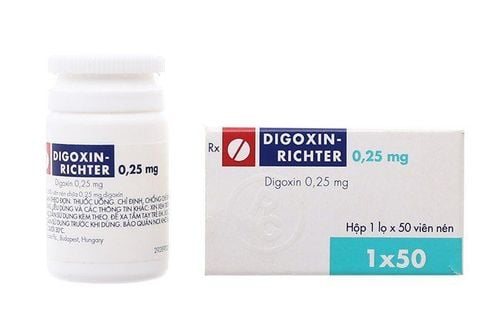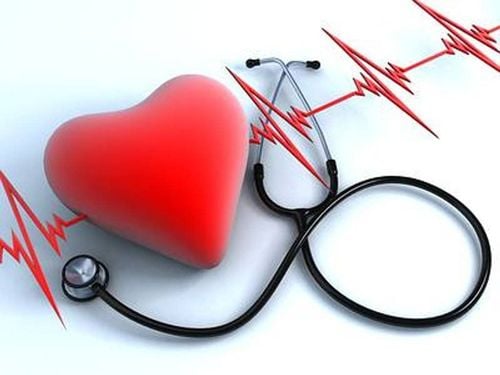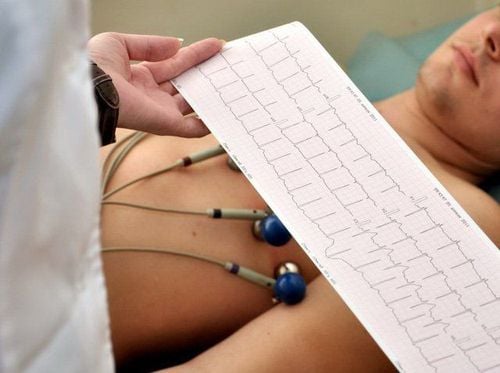This is an automatically translated article.
The article was professionally consulted by Dr. Nguyen Van Duong - Interventional Cardiologist - Cardiovascular Center - Vinmec Central Park International General Hospital. The doctor has many years of experience in the diagnosis and treatment of cardiovascular diseases.Atrioventricular block (AV block) is a conduction disorder from the atria to the ventricles that causes arrhythmias of many causes. Depending on the block level, there are different dangerous properties.
1. Learn about atrioventricular block
Atrioventricular block is a partial or complete obstruction of the conduction of impulses from the atria to the ventricles manifested by prolongation of the PR interval on the electrocardiogram. The most common cause is fibrosis or necrosis of the conduction system.Why does atrioventricular block occur? The atrioventricular node conducts and controls electrical impulses from the atria to the ventricles. Impulses conduction from the sinus node to the atria cause the atria to contract, as shown by the P wave on the electrocardiogram. It is then transmitted to the atrioventricular node, bundle of His, to the Purkinje network, causing the ventricles to contract, showing the QRS complex on the electrocardiogram. When the impulses from the atria to the ventricles are obstructed to varying degrees at the atrioventricular node or bundle of His, it is called atrioventricular block.
Depending on the degree of obstruction, the conduction of impulses from the atria to the ventricles, atrioventricular block is divided into 3 degrees: atrioventricular block I, II, III.
2. Causes of atrioventricular block
For first degree AV block or 1st degree atrioventricular blockExercise exercise Lower wall myocardial infarction Mitral valve replacement surgery, mitral valve repair Myocarditis Due to drugs such as beta-blockers, calcium channel blockers, digoxin , amiodarone

Lower wall myocardial infarction Idiopathic fibrosis of the conduction system in Lenegre disease or Lev disease Surgical repair of the mitral valve. Myocarditis, Lyme disease Autoimmune disease (lupus erythematosus, systemic sclerosis). Hyperkalemia. Medications: beta-blockers, calcium channel blockers, digoxin, amiodarone. For third-degree or complete atrioventricular block:
The causes are the same as second-degree atrioventricular (AV) block The most important etiologies are: Lower-wall myocardial infarction; calcium channel blockers, beta blockers, digoxin; Lenegre disease or Lev disease causes degeneration of the conduction system causing third degree atrioventricular block.
3. Is AV block dangerous?
3.1. First-degree atrioventricular block First-degree atrioventricular block is a disease of the heart's electrical impulse conduction system that causes the PR interval to be longer than normal (PR interval >200ms). Does not cause hemodynamic disturbances is not dangerous. No specific treatment is needed. Some cases of first-degree AV block with right bundle branch block may increase the risk of progression to third-degree AV block, so close monitoring is required.
Mobitz I second-degree atrioventricular block is characterized by a progressively longer PR interval on the electrocardiogram followed by a blocked P wave (loss of a QRS complex). Most type 1 second-degree atrioventricular block is benign and does not require any special treatment. Mobitz I is associated with a low risk of progression to third-degree atrioventricular (AV) block. A permanent pacemaker can be inserted rarely when needed. Atrioventricular block type II type 2 (Mobitz II).
Most patients have no symptoms. However, some people may have the following signs: lightheadedness, dizziness, fatigue depending on the rate of heart block. Mobitz II can cause severe bradycardia and progression to third-degree atrioventricular (AV) block, the risk of systolic heart failure therefore requires early treatment. Progression to third-degree AV block may lead to transient syncope known as Stokes-Adams attacks, cardiac arrest, or sudden death. In this case, it is necessary to quickly install a temporary pacemaker and finally a permanent pacemaker. 3.3. Third-degree atrioventricular block Patients with third-degree AV block often have a very slow heart rate (maybe as little as 28 beats/minute), low blood pressure, so the circulating flow often does not meet the body's needs. so the patient may be tired, dizzy, faint,... Third degree atrioventricular block may be in the setting of myocardial infarction. In particular, inferior myocardial infarction often causes third-degree AV block, the damage is usually transient, and the atrioventricular node is reversible. Anterior myocardial infarction can cause third-degree atrioventricular block, extensive damage, and irreversible conduction system, so permanent pacemaker implantation is required. Patients with third-degree atrioventricular (AV) block are at increased risk of cardiac arrest and sudden cardiac death. Requires urgent hospitalization for cardiac monitoring, temporary pacing, or permanent pacemaker placement.

Please dial HOTLINE for more information or register for an appointment HERE. Download MyVinmec app to make appointments faster and to manage your bookings easily.














